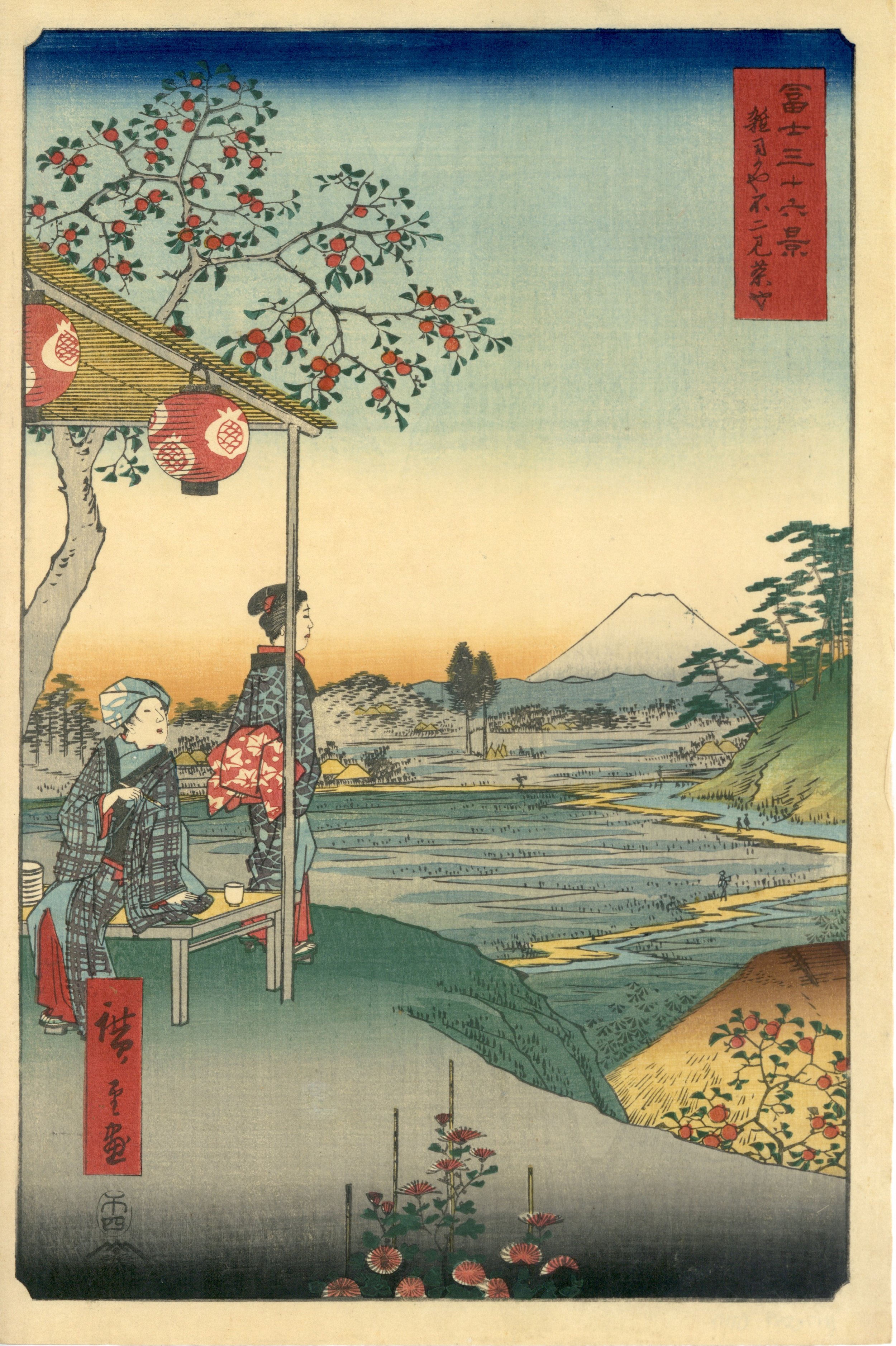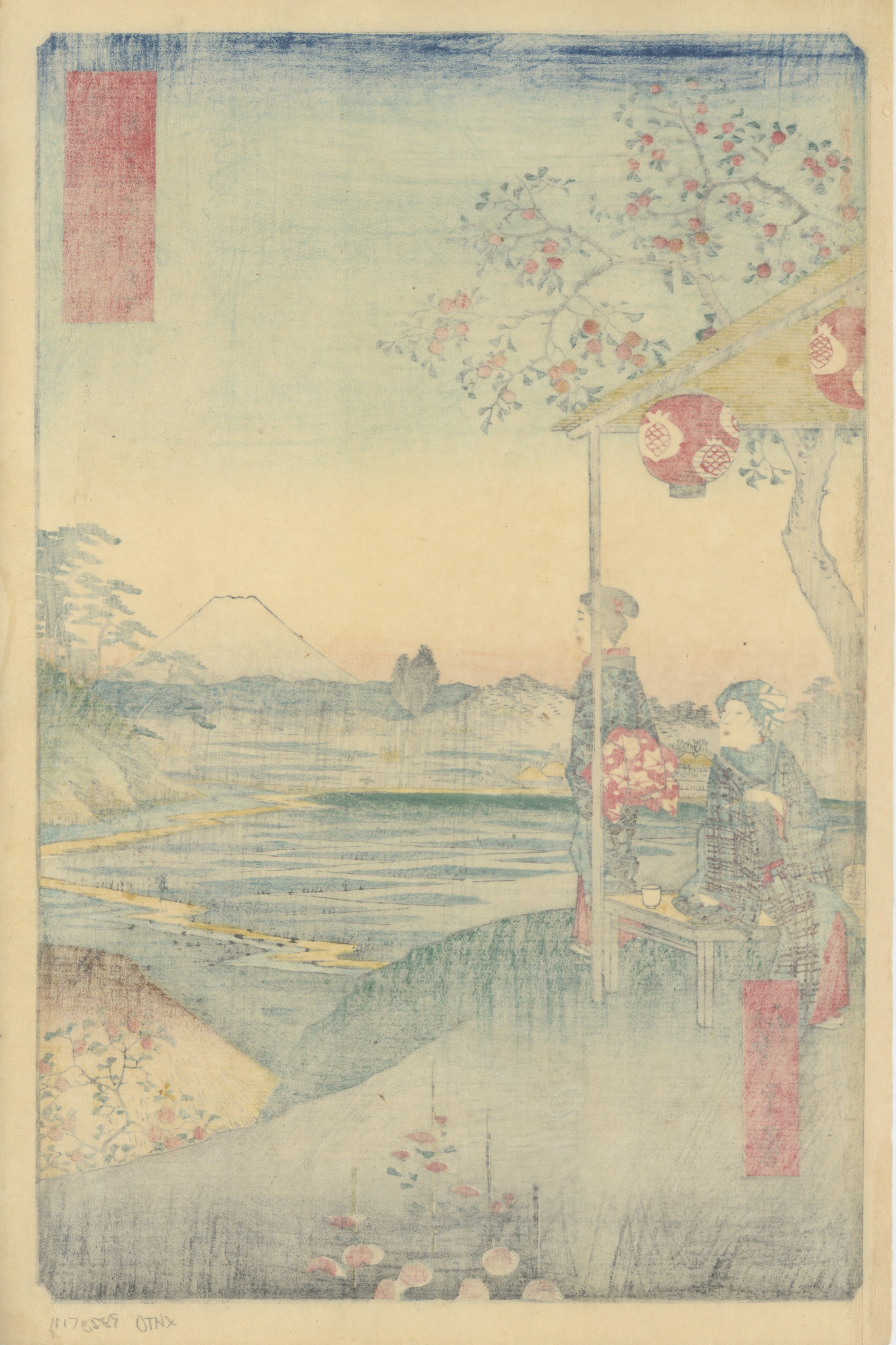Hiroshige | Zoshigaya, 36 Views of Mt. Fuji
歌川広重 Utagawa Hiroshige (1797-1858)
富士三十六景 雑司かや不二見茶や
Zoshigaya fujimi chaya, from the series of Thirty-six Views of Mount Fuji
1858
木版画 | 纵绘大判 | 36cm x 25cm
Woodblock-print | Oban tate-e | 36cm x 25cm
非常早期的版次;品相非常好
Very early impression; great condition
SOLD
提到“富士”与“三十六景”,大家首先想到的,应该都是北斋于1830-1832年间创作的那套横绘风景画《富岳三十六景》。毕竟,这是一套包含有《神奈川冲浪里》《山下白雨》《凯风快晴》等一众名品的神作。但大多数人并不了解的是,广重也曾创作过名为《富士三十六景》的风景画系列,并且还有两套:一套为1852年创作的中判横绘;另一套则为1858年创作,1859年广重逝世后发行的大判纵绘,即本作来源。提起杂司谷,就必须谈到著名的法明寺鬼子母神堂。这座位于今东京都丰岛区杂司谷,现已成为日本国家重要文化财的堂宇,正是江户城三大鬼子母神供奉地之一。作为护持佛法,掌管生育与安产之神,鬼子母神在江户时代就收获了颇多女性信众。因此本作的取景地,就被推断为是通往法明寺鬼子母神堂道路的某处茶屋。红柿满挂枝,赤菊遍地栽。每年十月中旬,盛大的御会式祭典就会在鬼子母神堂如期举行。只见杂司谷的一座高台茶屋中,有两位参加祭典的姑娘正稍作休整:一位头戴蓝布巾,手捏烟管吸烟解乏;一位侧身站立遥望远方。顺目光望去,坡底平原村落中,畦田稻谷早已收割尽,一弯溪水碧蓝,一曲小径流金。最右侧布满青松的鼠山外,雪满身的富士坐落在万里晴空下,似乎与这位美人儿对望。金风中,大红的多子石榴纹灯笼轻轻摇摆,想到有了神明和圣山的双重庇佑,姑娘的脸上,也不自觉地泛起一抹笑容。
Interested in purchasing?
Please contact us.
歌川広重 Utagawa Hiroshige (1797-1858)
富士三十六景 雑司かや不二見茶や
Zoshigaya fujimi chaya, from the series of Thirty-six Views of Mount Fuji
1858
木版画 | 纵绘大判 | 36cm x 25cm
Woodblock-print | Oban tate-e | 36cm x 25cm
非常早期的版次;品相非常好
Very early impression; great condition
SOLD
提到“富士”与“三十六景”,大家首先想到的,应该都是北斋于1830-1832年间创作的那套横绘风景画《富岳三十六景》。毕竟,这是一套包含有《神奈川冲浪里》《山下白雨》《凯风快晴》等一众名品的神作。但大多数人并不了解的是,广重也曾创作过名为《富士三十六景》的风景画系列,并且还有两套:一套为1852年创作的中判横绘;另一套则为1858年创作,1859年广重逝世后发行的大判纵绘,即本作来源。提起杂司谷,就必须谈到著名的法明寺鬼子母神堂。这座位于今东京都丰岛区杂司谷,现已成为日本国家重要文化财的堂宇,正是江户城三大鬼子母神供奉地之一。作为护持佛法,掌管生育与安产之神,鬼子母神在江户时代就收获了颇多女性信众。因此本作的取景地,就被推断为是通往法明寺鬼子母神堂道路的某处茶屋。红柿满挂枝,赤菊遍地栽。每年十月中旬,盛大的御会式祭典就会在鬼子母神堂如期举行。只见杂司谷的一座高台茶屋中,有两位参加祭典的姑娘正稍作休整:一位头戴蓝布巾,手捏烟管吸烟解乏;一位侧身站立遥望远方。顺目光望去,坡底平原村落中,畦田稻谷早已收割尽,一弯溪水碧蓝,一曲小径流金。最右侧布满青松的鼠山外,雪满身的富士坐落在万里晴空下,似乎与这位美人儿对望。金风中,大红的多子石榴纹灯笼轻轻摇摆,想到有了神明和圣山的双重庇佑,姑娘的脸上,也不自觉地泛起一抹笑容。
Interested in purchasing?
Please contact us.
歌川広重 Utagawa Hiroshige (1797-1858)
富士三十六景 雑司かや不二見茶や
Zoshigaya fujimi chaya, from the series of Thirty-six Views of Mount Fuji
1858
木版画 | 纵绘大判 | 36cm x 25cm
Woodblock-print | Oban tate-e | 36cm x 25cm
非常早期的版次;品相非常好
Very early impression; great condition
SOLD
提到“富士”与“三十六景”,大家首先想到的,应该都是北斋于1830-1832年间创作的那套横绘风景画《富岳三十六景》。毕竟,这是一套包含有《神奈川冲浪里》《山下白雨》《凯风快晴》等一众名品的神作。但大多数人并不了解的是,广重也曾创作过名为《富士三十六景》的风景画系列,并且还有两套:一套为1852年创作的中判横绘;另一套则为1858年创作,1859年广重逝世后发行的大判纵绘,即本作来源。提起杂司谷,就必须谈到著名的法明寺鬼子母神堂。这座位于今东京都丰岛区杂司谷,现已成为日本国家重要文化财的堂宇,正是江户城三大鬼子母神供奉地之一。作为护持佛法,掌管生育与安产之神,鬼子母神在江户时代就收获了颇多女性信众。因此本作的取景地,就被推断为是通往法明寺鬼子母神堂道路的某处茶屋。红柿满挂枝,赤菊遍地栽。每年十月中旬,盛大的御会式祭典就会在鬼子母神堂如期举行。只见杂司谷的一座高台茶屋中,有两位参加祭典的姑娘正稍作休整:一位头戴蓝布巾,手捏烟管吸烟解乏;一位侧身站立遥望远方。顺目光望去,坡底平原村落中,畦田稻谷早已收割尽,一弯溪水碧蓝,一曲小径流金。最右侧布满青松的鼠山外,雪满身的富士坐落在万里晴空下,似乎与这位美人儿对望。金风中,大红的多子石榴纹灯笼轻轻摇摆,想到有了神明和圣山的双重庇佑,姑娘的脸上,也不自觉地泛起一抹笑容。
Interested in purchasing?
Please contact us.
Utagawa Hiroshige (1797-1858)
Ando Hiroshige (1897-1858) revolutionized the art of landscape prints during the Edo era, building on the success of his senior, Hokusai, but taking a more poetic and naturalist approach to portraying the beauty of Japan.
The son of a low-level Samurai assigned to the fire brigade in Edo, Hiroshige became a student of the Utagawa school as a young man. His first prints focused on beautiful women (bijin), and views of Edo. But in 1833 he began work on his most famous early work, his first series depicting the Tokaido, the "Great Sea Road" between Edo and Tokyo.
Today there is some controversy about this series. Initially, it was believed that Hiroshige had travelled the route along with a local lord (Daimyo) who was making a gift of horses to the Emperor. But more recent scholarship suggests Hiroshige never travelled the road himself, at least not the entire way, and made his designs using published guidebooks.
Nonetheless, the prints were wonderful and revolutionary. They embraced the seasons with a gentle lyricism missing from Hokusai's striking but stylized depictions. In Hiroshige's work, nature is sacred -- but it is always mixed with humanity, with travelers or little inns or bridges. There is a magical harmony between man and the elements.
His depiction of the seasons and weather is especially evocative. Snow blankets some views with a hushed silence, while rain streaks down furiously in others. In some prints natured is agitated; in others, calm prevails. Produced in a horizontal oban yoko-e format, the series was a smash hit.
The Tokaido series made Hiroshige famous, and he became incredible prolific. In the 1840s he produced many strong designs, but many mediocre ones, too, including several subsequent Tokaido series of varying quality.
In 1853, however, he made a big step. He turned his landscapes sideways, embracing a bold vertical oban tate-e format. This gave his designs new energy and a modern feel. The first of these was Famous Views of the Sixty-Odd Provinces. From them on, most of his most noted series were executed in this format.
He saved his greatest for his last. In 1856 he began work on 100 Famous Views of Edo, which many consider his most exceptional work. Here his home city was portrayed with energy and passion, and in these 119 designs he created an incredible record of a vanished place. In addition to the striking vertical format, he developed exciting new compositions, often juxtaposing a strong foreground element with a distant background.
Among the many famous images in this series are Squall at Ohashi and the Plum Garden in Komeido. Both of these were copied by Vincent Van Gogh, a great admirer of Hiroshige. Thus, the great Japanese artist had a profound effect on Western art.
Alas, his beloved Edo ended his life. Hiroshige was claimed by a cholera epidemic that swept the city in 1958. His pupil Shigenobu, who took the name Hiroshige II, completed The Famous Views of Edo.


